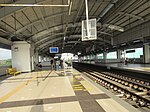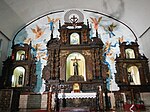Grace Christian College
1950 establishments in the PhilippinesAccuracy disputes from March 2022Chinese-language schools in Metro ManilaChinese-language schools in the PhilippinesEducational institutions established in 1950 ... and 4 more
High schools in Metro ManilaProtestant schools in the PhilippinesUniversities and colleges in Metro ManilaUniversities and colleges in Quezon City
Grace Christian College (GCC) (simplified Chinese: 菲律滨基督教灵惠学院; traditional Chinese: 菲律濱基督教靈惠學院; pinyin: Fēilǜbīn Jīdūjiào Línghuì Xuéyuàn; Pe̍h-ōe-jī: Hui-li̍p-pin Ki-tok-kàu Lêng-hūi Ha̍k-īⁿ), formerly known as Grace Christian High School (GCHS), is an evangelical Protestant school that caters primarily to Chinese Filipino students and provides education from Pre-Nursery to College. It is situated in Grace Village, Quezon City, Metro Manila, Philippines. Its current president is Dr. Christine Joy Tan, succeeding Dr. James L. Tan in May 2020.
Excerpt from the Wikipedia article Grace Christian College (License: CC BY-SA 3.0, Authors).Grace Christian College
Grace Avenue, Quezon City Balintawak
Geographical coordinates (GPS) Address External links Nearby Places Show on map
Geographical coordinates (GPS)
| Latitude | Longitude |
|---|---|
| N 14.650277777778 ° | E 121.005 ° |
Address
Grace Christian College
Grace Avenue
1106 Quezon City, Balintawak
Philippines
Open on Google Maps









